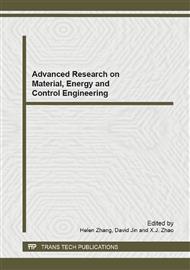[1]
Gao, Q., Li, Y., Wan, Y., Qin, X., Jiangcun, W., Liu, Y., 2009. Dynamics of alpine grassland NPP and its response to climate change in Northern Tibet. Climatic Change 97, 515-528.
DOI: 10.1007/s10584-009-9617-z
Google Scholar
[2]
Lieth, H., 1975. Modeling the primary productivity of the world Primary, productivity of the biosphere, 14, Springer-Verlag Berlin, pp.237-263.
DOI: 10.1007/978-3-642-80913-2_12
Google Scholar
[3]
Cramer, W., Kicklighter, D., Bondeau, A., Moore, B., Churkina, G., Nemry, B., Ruimy, A., Schloss, A., 1999. Comparing global models of terrestrial net primary productivity (NPP) overview and key results. Global Change Biol. 5, 1-15.
DOI: 10.1046/j.1365-2486.1999.00009.x
Google Scholar
[4]
Wang, J., Meng, J., Cai, Y., 2008. Assessing vegetation dynamics impacted by climate change in the southwestern karst region of China with AVHRR NDVI and AVHRR NPP time-series. Environ. Geol. 54, 1185-1195.
DOI: 10.1007/s00254-007-0901-9
Google Scholar
[5]
Fotheringham, A., Brunsdon, C., Charlton, M., 2002. Geographically weighted regression the analysis of spatially varying relationships. John Wiley & Sons Inc.
DOI: 10.1111/j.1538-4632.2003.tb01114.x
Google Scholar
[6]
Zhao, N., Yang, Y., Zhou, X., 2010. Application of geographically weighted regression in estimating the effect of climate and site conditions on vegetation distribution in Haihe Catchment, China. Plant Ecol. 209, 349-359.
DOI: 10.1007/s11258-010-9769-y
Google Scholar
[7]
Foody, G., 2003. Geographical weighting as a further refinement to regression modelling an example focused on the NDVI-rainfall relationship. Remote Sens Environ. 88, 283-293.
DOI: 10.1016/j.rse.2003.08.004
Google Scholar
[8]
Wang, Q., Ni, J., Tenhunen, J., 2005. Application of a geographically-weighted regression analysis to estimate net primary production of Chinese forest ecosystems. Global Ecol. Biogeogr. 14, 379-393.
DOI: 10.1111/j.1466-822x.2005.00153.x
Google Scholar
[9]
Cao, M., Woodward, F., 1998. Net primary and ecosystem production and carbon stocks of terrestrial ecosystems and their responses to climate change. Global Change Biol. 4, 185-198.
DOI: 10.1046/j.1365-2486.1998.00125.x
Google Scholar
[10]
Ju, W., Chen, J., Harvey, D., Wang, S., 2007. Future carbon balance of China's forests under climate change and increasing CO2. J. Environ. Manag. 85, 538-562.
DOI: 10.1016/j.jenvman.2006.04.028
Google Scholar
[11]
Yu, L., Cao, M., Li, K., 2006. Climate-induced changes in the vegetation pattern of China in the 21st century. Ecol. Res. 21, 912-919.
DOI: 10.1007/s11284-006-0042-8
Google Scholar


